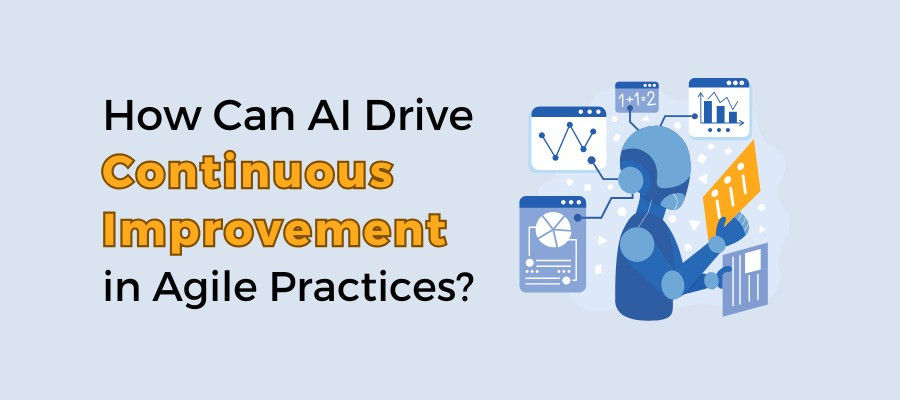How Can AI Drive Continuous Improvement in Agile Practices?

Agile practices thrive on continuous improvement, with Scrum Masters playing a pivotal role in fostering adaptability, transparency, and team collaboration. Yet, achieving and maintaining this improvement cycle isn’t without its challenges. Metrics must be tracked, team dynamics must be understood, and decisions must be adapted swiftly—all while ensuring alignment with Agile values.
Enter AI: The modern ally for Scrum Masters aiming to amplify Agile’s impact. Let’s explore how AI-driven tools and systems empower Scrum Masters to champion continuous improvement effectively.
The Importance of Continuous Improvement in Agile
Continuous improvement is the backbone of Agile. With it, teams can avoid stagnation, undermining the iterative nature of Agile frameworks like Scrum. For Scrum Masters, the mandate to drive improvements encompasses:
- Identifying inefficiencies: Recognizing process bottlenecks or delivery issues promptly.
- Fostering a feedback culture: Encouraging teams to reflect on successes and failures to enable growth.
- Aligning with organizational goals: Ensuring improvements contribute to business value while adhering to Agile principles.
However, traditional approaches to continuous improvement can often be reactive, relying heavily on post-sprint retrospectives and manual data collection. AI bridges this gap by turning insights into proactive, actionable recommendations.
How AI Transforms Agile Improvement
Now, let’s bring out the prominent use cases of Artificial Intelligence to deliver continuous improvement among agile teams!
Real-Time Data Analytics
AI tools process vast amounts of data from sprint boards, team collaboration platforms, and project management tools. These systems provide actionable insights into real-time velocity trends, task completion rates, and blockers, enabling Scrum Masters to address issues immediately.
Example: Tools like Jira and Miro integrated with AI modules can identify recurring sprint challenges, such as unplanned work or excessive task switching.
Enhanced Retrospective Analysis
AI simplifies the process of analyzing sprint retrospectives by identifying patterns in feedback and performance metrics. Predictive models can highlight areas where future improvements might yield the most significant impact, helping Scrum Masters craft more effective action plans.
Facilitating Better Team Dynamics
AI can provide insights into team cohesion and morale by analyzing communication patterns, meeting behaviors, and collaboration metrics. Scrum Masters can leverage this data to address conflicts or improve engagement strategies.
Example: AI-driven sentiment analysis tools can identify dips in team morale, flagging intervention opportunities before issues escalate.
Automating Administrative Tasks
Agile ceremonies such as sprint planning and backlog grooming often involve tedious tasks. AI tools can automate prioritization suggestions, predict task dependencies, and recommend sprint goals based on historical data. This allows Scrum Masters to focus more on strategic leadership than repetitive processes.
AI Systems for Continuous Improvement
Here’s how Scrum Masters can use AI tools to optimize Agile practices:
- Predictive Analytics:
Tools powered by AI forecast potential risks and deviations in sprint goals. For example, if a project is likely to miss a deadline due to resource constraints, these systems suggest adjustments proactively.
- Capacity Planning:
AI tools evaluate team workloads and capabilities, enabling Scrum Masters to allocate resources more effectively. Overloaded or underutilized team members are flagged, ensuring balanced workloads.
- Custom Dashboards:
Dynamic dashboards powered by AI collate data from multiple sources, offering a 360-degree view of Agile metrics. This makes it easier for Scrum Masters to visualize progress and identify areas of concern without manual aggregation.
Why AI Matters for CSM Professionals
Certified Scrum Masters (CSMs) are uniquely positioned to embrace AI to drive Agile excellence. By incorporating AI tools:
- They become enablers of innovation: Scrum Masters can focus on cultivating creativity within teams rather than being bogged down by data-heavy tasks.
- They ensure Agile scalability: AI provides the infrastructure to scale Agile practices across more significant, complex projects without compromising quality.
- They gain an edge in leadership: AI-savvy Scrum Masters lead with precision, ensuring their teams consistently deliver high-value outcomes.
For professionals aspiring to deepen their expertise, CSM training from PremierAgile offers a comprehensive foundation in Agile leadership. Participants not only master core Scrum principles but also learn to integrate modern tools, including AI, to enhance team performance and continuous improvement.
The Future of Continuous Improvement with AI
AI isn’t just a tool; it’s a catalyst for transforming Agile practices. Scrum Masters leveraging AI redefine how teams collaborate, adapt, and innovate in fast-paced environments. With AI-driven insights, they can transition from reactive problem-solving to proactive leadership, creating a culture of sustained excellence.
If you’re ready to lead your teams into the future of Agile, investing in CSM training is the first step. Learn to merge the power of AI with Scrum principles to unlock unparalleled team potential and become an actual change agent in the Agile ecosystem.
Reference:
AI Meets Agile: Transforming Project Management For The Future




